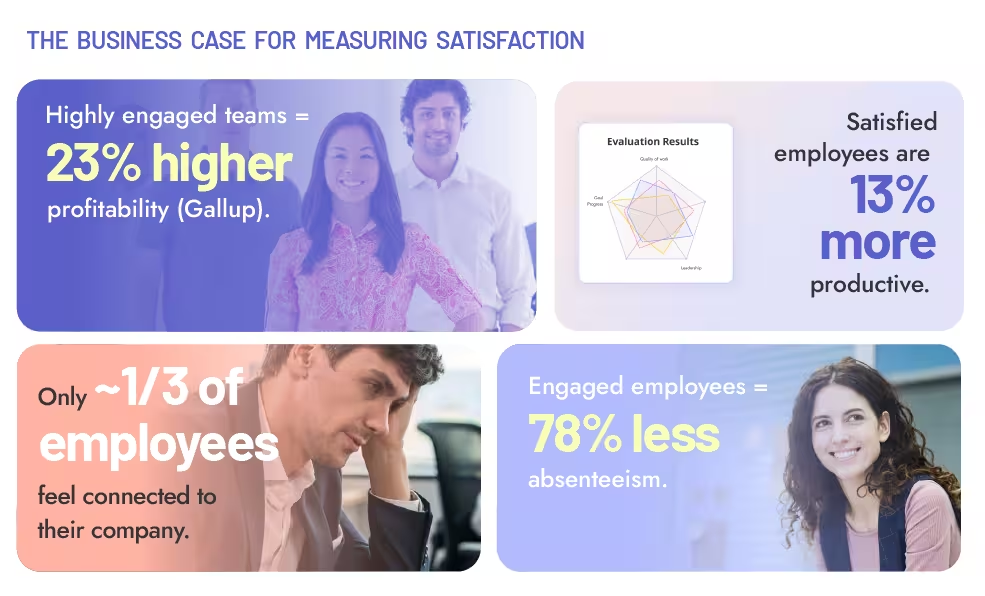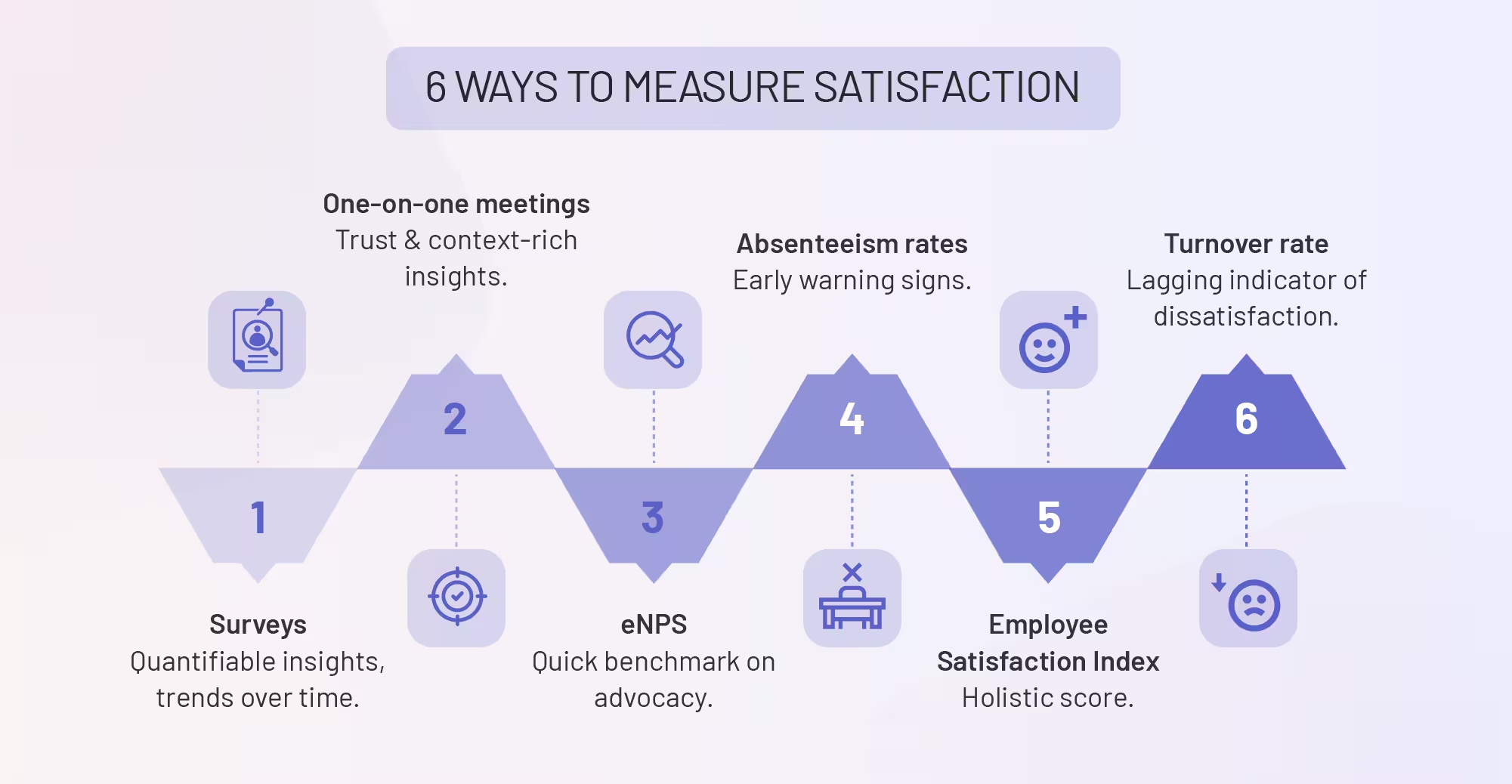Get the Ebook
.svg)
Employee satisfaction is directly tied to business results. According to Gallup's Q12 engagement survey, highly engaged teams see a 23% increase in profitability and a 78% reduction in absenteeism. Despite this, only about a third of employees feel a genuine connection to their work or company.
To accurately gauge employee satisfaction, you need more than an annual survey. A clear, data-driven approach that tracks key metrics and gathers authentic feedback is essential. Knowing how to measure this satisfaction can help you decrease turnover, boost productivity, and create a workplace where people want to be.
Here are the most effective ways on how to measure employee satisfaction in your organization.
Employee satisfaction represents how content and fulfilled your team members feel about their work experience. It encompasses their feelings about compensation, work environment, leadership quality, growth opportunities, and work-life balance.
Several key factors influence how satisfied employees are at work:

Measuring employee satisfaction benefits organizations in several important ways. It provides insights that can improve retention, productivity, and overall business health. The key benefits of measuring employee satisfaction are:

Different measurement methods provide unique insights into your team's satisfaction levels. Combining multiple approaches gives you a complete picture of where your organization stands.
Surveys remain the most direct way to measure employee satisfaction across your organization. They provide quantifiable data that you can track over time and compare across departments.
How do surveys help measure employee satisfaction?
Best practices for employee satisfaction surveys:
Creating an employee satisfaction survey template saves time and ensures consistency. Teamflect offers customizable survey templates that integrate directly with Microsoft Teams, making distribution and analysis seamless.
Regular one-on-one meetings provide qualitative insights that surveys often miss. These conversations build relationships while uncovering satisfaction issues in real-time.
How can 1:1s improve measurement of satisfaction?
Best practices for 1:1s:
The employee net promoter score measures how likely your team members are to recommend your organization as a great place to work. This single metric provides a quick satisfaction benchmark.
How does eNPS measure satisfaction?
Best practices for eNPS:
Exit interviews provide direct feedback about satisfaction gaps that led to departure decisions. This data helps prevent similar issues with remaining team members.
Maximizing exit interview value:
The Employee Satisfaction Index combines multiple satisfaction factors into a single score. This comprehensive metric provides a holistic view of organizational satisfaction.
ESI calculation includes:
Most organizations calculate ESI by averaging scores across these key areas, weighted by importance to your specific workplace culture.
Casual workplace conversations often reveal satisfaction insights that formal measurements miss. Train managers to recognize and document satisfaction indicators during regular interactions.
Benefits of informal feedback:
Suggestion systems provide ongoing channels for satisfaction-related feedback. Modern digital versions integrate with existing communication platforms for higher participation rates.
Effective suggestion systems:
Modern satisfaction measurement requires tools that can handle multiple data sources and provide actionable insights. Software solutions streamline collection, analysis, and reporting processes.
Benefits of satisfaction software:
Teamflect's employee engagement survey software integrates directly with your existing Microsoft Teams workflow, making satisfaction measurement a natural part of your team's routine.
Beyond primary measurement methods, several supporting metrics provide additional satisfaction insights. These indicators help validate your primary satisfaction data.
Your public Glassdoor rating reflects how current and former employees perceive your organization. This external metric provides unfiltered satisfaction feedback.
Why Glassdoor ratings matter:
Monitor your rating monthly and respond professionally to negative reviews. Use feedback themes to identify improvement opportunities.
High internal promotion rates indicate that employees see growth opportunities within your organization. Career advancement directly correlates with long-term satisfaction.
Tracking promotion effectiveness:
Organizations with strong internal promotion rates retain talent longer and maintain higher satisfaction scores overall.
New employee retention during probationary periods indicates satisfaction with role expectations and workplace culture. High early turnover suggests misalignment between promises and reality.
Why probation retention matters:
Track retention at 30, 60, and 90-day intervals to identify optimal intervention points.
High absenteeism often signals underlying satisfaction problems. People who enjoy their work and feel valued show up consistently.
Why absenteeism matters for satisfaction:
Calculate absenteeism by dividing total absent days by total scheduled work days, then multiply by 100. In 2024, the average annual absence rate in the United States was 3.2%, though this figure varies across different sectors.
Your employee turnover rate serves as a lagging indicator of satisfaction problems. High turnover often reflects deeper satisfaction issues that need immediate attention.
Connection between turnover and satisfaction:
Track both voluntary and involuntary turnover separately. Voluntary departures provide clearer insights into satisfaction-related retention challenges.
Note, though, that turnover rates differ from employee attrition rate. It refers to the percentage of employees who leave but are usually replaced, while the latter refers to employees that leave and aren’t replaced.
Performance reviews contain satisfaction indicators when structured properly. Low performance scores often correlate with satisfaction problems that need attention.
Using performance data for satisfaction insights:
Artificial intelligence and advanced analytics improve how organizations measure employee satisfaction by offering deeper insights and predictive abilities not possible with traditional methods.
Teamflect uses AI and analytics to track and improve employee satisfaction. It provides sentiment analysis, collects real-time feedback, predicts engagement risks, and shows clear dashboards to help managers act quickly.
Learning how to measure employee satisfaction is now a continuous, data-driven process. It’s essential for business success. Companies that regularly measure satisfaction use surveys, one-on-one meetings, and metrics like eNPS and turnover rate. This helps reduce absenteeism, increase productivity, and improve retention.
Transform how you measure and improve employee satisfaction with Teamflect. It provides the comprehensive tools you need to track satisfaction across your entire organization.
Our platform integrates seamlessly with Microsoft Teams to deliver employee satisfaction survey templates, automated pulse surveys, and real-time analytics. You can conduct meaningful one-on-ones, track key satisfaction metrics, and identify trends before they become problems.
Combine multiple methods including surveys, one-on-one meetings, eNPS scores, and behavioral metrics like absenteeism and turnover rates. Use both quantitative data and qualitative feedback for complete insights.
The most effective approaches include regular pulse surveys, structured one-on-one meetings, employee Net Promoter Score tracking, and analyzing key metrics like internal promotion rates and retention data.
Key metrics include eNPS scores, Employee Satisfaction Index (ESI), absenteeism rates, voluntary turnover rates, internal promotion rates, Glassdoor ratings, and probationary period retention rates.
Design engagement surveys using digital tools, schedule regular video one-on-ones, track engagement in virtual meetings, monitor collaboration tool usage patterns, and conduct frequent pulse surveys to maintain connection.
Most organizations use a 1-10 scale where 1 represents "extremely dissatisfied" and 10 represents "extremely satisfied." Some prefer 1-5 scales for simplicity. The key is consistency across all measurements.
An all-in-one performance management tool for Microsoft Teams
